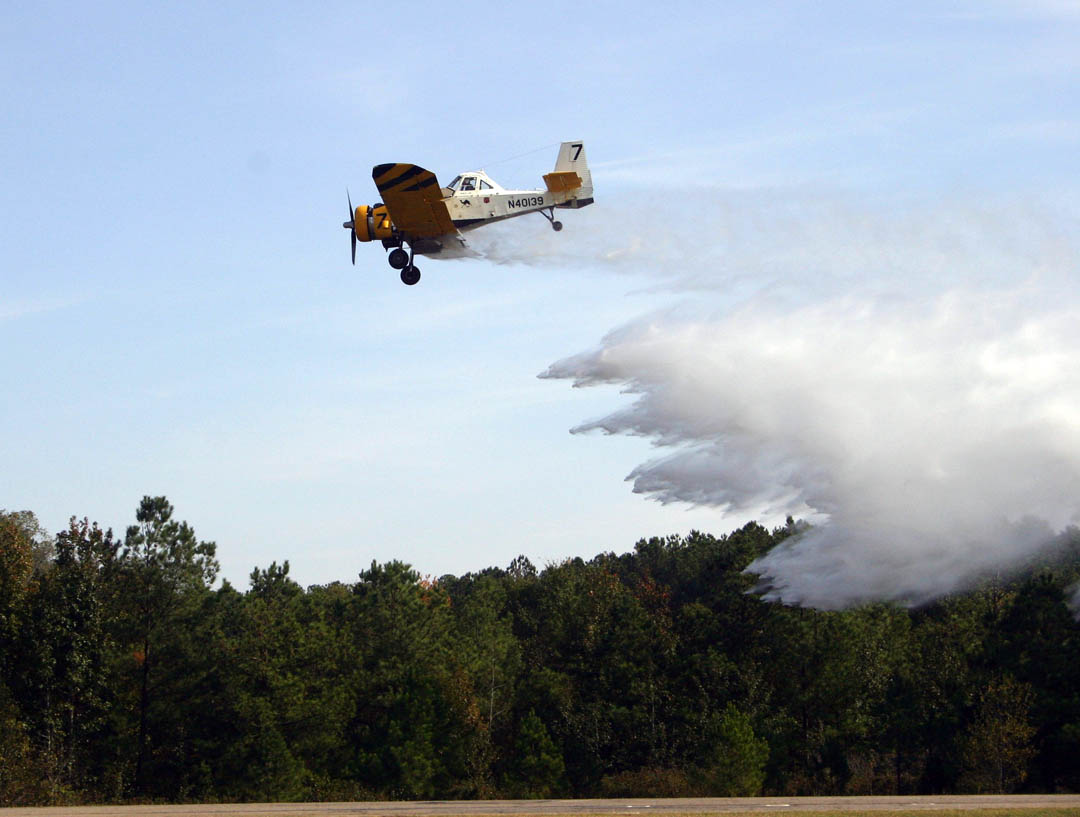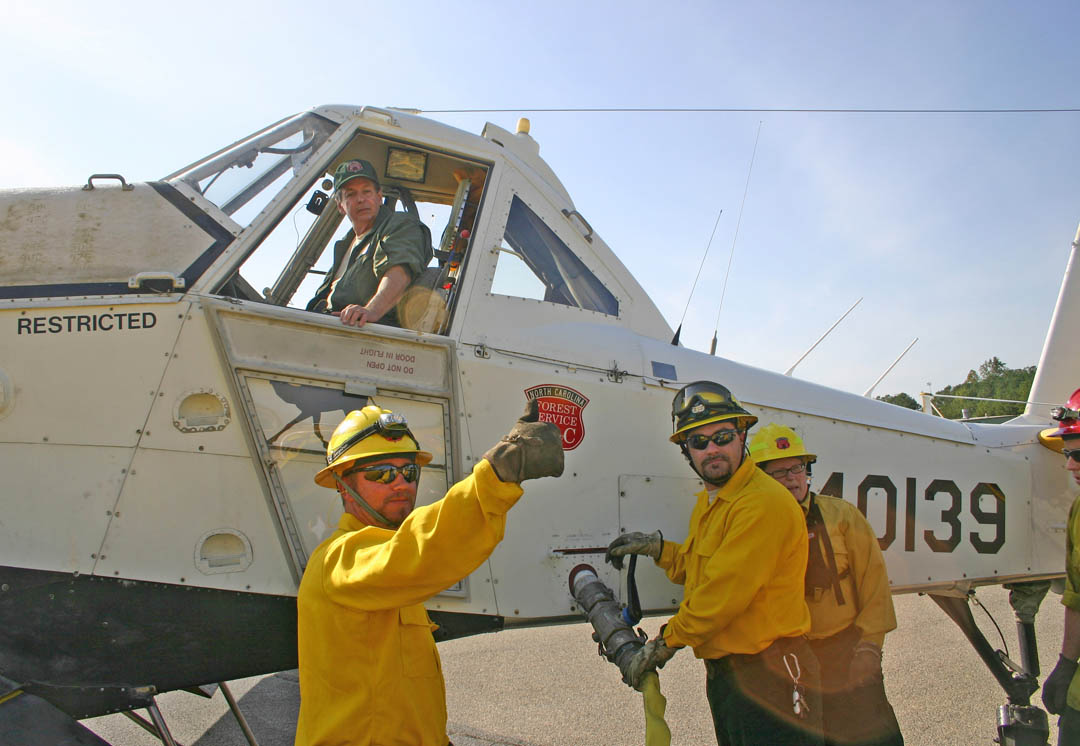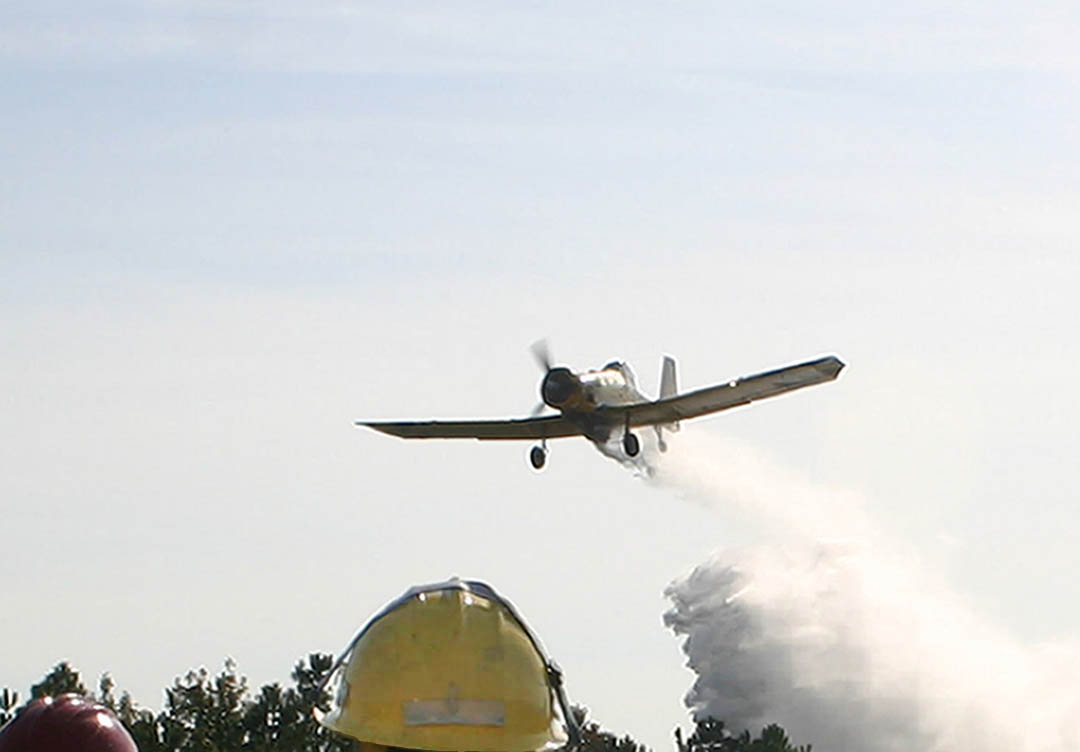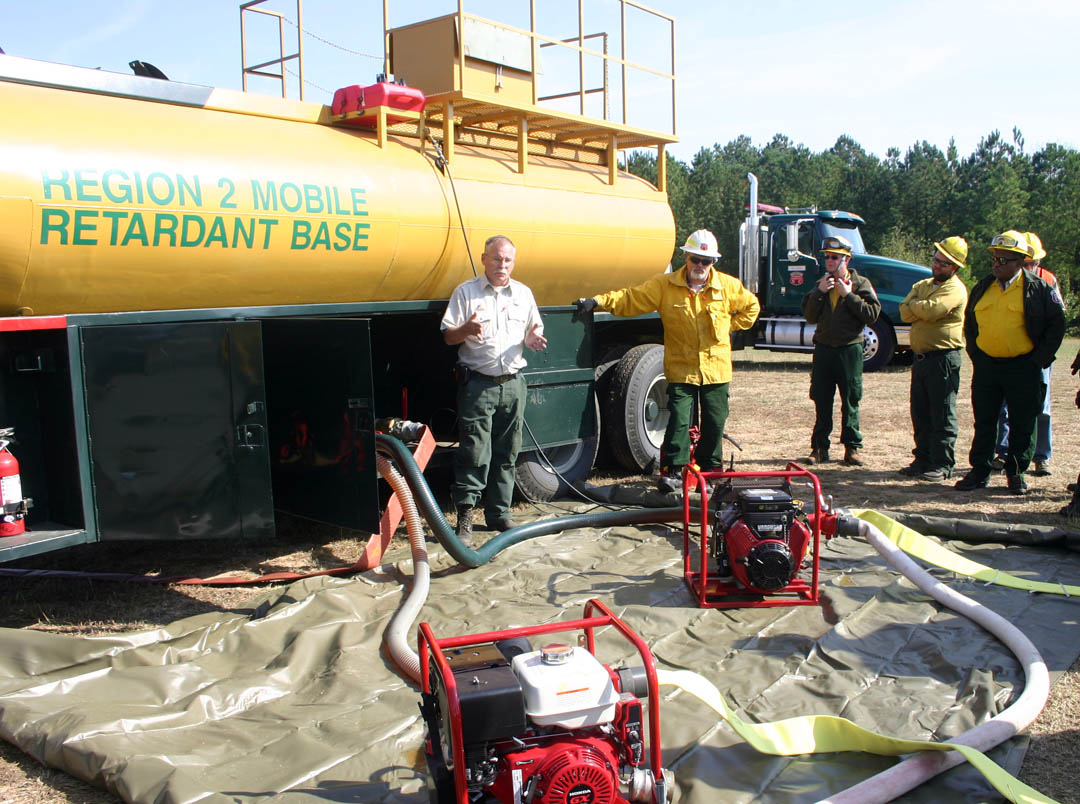
College News
Forest Service flies high over CCCC Emergency Services Training Center
11.15.2010 • College & Community, Continuing Education, Facilities/Buildings
SANFORD – The Dromader M18 air tanker flew low over the runway at Central Carolina Community College’s Emergency Services Training Center. Suddenly, 400 gallons of water poured from the plane’s tank, saturating the area below.
Smiles spread over the faces of the Forest Service fire-fighting trainees and trainers watching the successful run. Had this been a forest fire, the air tanker would have dumped fire retardant rather than water.
The small air tanker circled the wooded area around the Center, then Forest Service pilot Ernie Williams brought it in for a smooth landing, taxiing to a stop not far from where the fire fighting ground crew trainers and trainees stood.
Immediately the 24 trainees, primarily from the five districts in the Forest Service’s Region 2 (Piedmont area), moved into action, practicing the ground base crew operations that support aerial fire suppression.
Some climbed onto the Forest Service’s large, bright yellow Mobile Retardant Base Operations tanker. Others manned two large pumps that moved water from the base tanker to the plane. Still others connected long fire hoses to the plane’s tank to refill it for another drop. The fire fighting trainees worked quickly and efficiently, using the skills and practicing the safety measures they were learning.
“The ESTC is an awesome place for this type of training since it was formerly an airport,” said Hannah Thompson-Welch, an assistant county Forest Service District 5 ranger based in Wayne County. I don’t know of any other college that has access to runways. It’s invaluable for training operations such as this.”
Thompson-Welch is the public information officer for District 5. She is also a fire fighter. Forest Service personnel are cross-trained to assist in fighting forest fires as needed. At the Nov. 1 training, she headed one of the six-person crews learning and practicing the critical preparation.
Ron Hollifield, Forest Service District 10 ranger, from Lexington, was in charge of the Region 2 training exercise. Mark Luellen, District 3 retired head forest ranger for Lee County, served as the safety liaison officer. Region 2 stretches from Surry County to Northampton County and south to Robeson County, including the local area of Chatham, Harnett, Lee and Moore counties.
“Air tankers don’t put out forest fires,” Hollifield said as he watched the plane line up perfectly for another drop. “They just knock it back so the ground crews can get in there and fight it.”
According to the N.C. Division of Forest Resources web site, in 2009 its personnel fought about 3,300 fires affecting 12,300 acres. The Forest Service has three Dromader M18 single engine air tankers (SEATS), all based in Kinston. The Polish-built plane with its 60-foot wing span was originally designed for crop dusting, but its small size and maneuverability make it ideal for flying low over forest fires and dumping flame retardant on them.
Hollifield said the Mobile Retardant Base Operations tanker was a federal excess property fuel tanker that the Forest Service’s Region 2 refurbished for fire fighting. He said it would have cost $250,000 to buy the tanker new, but the Service was able to buy and refurbish it for only $10,000. It holds 4,000 gallons of water plus 900 gallons in the water-retardant mixing compartment.
Prior to putting it in service, planes had to return to Kinston to reload with retardant. Now, the base tanker can be driven to the area of a fire and the planes can load, dump and reload, saving critical time and greatly increasing the Service’s ability to react quickly and effectively.
Training is held with the Mobile Retardant Base Operations tanker every other year. This was the Service’s first training event at the ESTC. The trainers and trainees were impressed with the facility.
“The ESTC is a good, central location for the Forest Service’s Region 2,” Hollifield said. “Having a runway available without having to compete with other planes is invaluable. We hope to identify the ESTC as a place where Forest Service firefighters could base if a wildfire broke out in this area.”
For more information about Central Carolina Community College’s Emergency Services Training Center, go online to
www.cccc.edu/estc or call (919) 776-5601. For more information about the N.C. Forest Service, go to http://www.dfr.nc.gov.

An N.C. Forest Service pilot Dromader M-18 air tanker drops 400 gallons of water onto the runway at Central Carolina Community College’s Emergency Services Training Center. Forest Service pilot Ernie Williams made four drops during a Nov. 1 aerial fire fighting ground crew training exercise. Twenty-four Forest Service personnel primarily from the Service’s Region 2 (Piedmont area) were trained in how to refill the air tanker from the Service’s 4.900-gallon mobile retardant base tanker.

North Carolina Forest Service Pilot Ernie Williams watches as District 5 Assistant County Ranger James Dupree (left), of Greene County, gives a ‘thumbs-up’ to the crew controlling the tank loading pumps during a Nov. 1 Forest Service ground crew training session at Central Carolina Community College’s Emergency Services Training Center. District 5 Assistant County Ranger Brandon Hill (center), of Wayne County, has attached the hose to the plane’s tank as Hannah Thompson-Welch (right), assistant county ranger for Wayne County, observes. Twenty-four Forest Service personnel, primarily from the Service’s Region 2 (Piedmont area), were trained in how to refill the air tanker from the Service’s 4,900-gallon mobile retardant base tanker.

North Carolina Forest Service personnel (right) man the pumps controlling the flow of water to one of the Service’s Dromader M-18 single engine air tanker as others (back, left) attach the hose and monitor the flow during a Nov. 1 Forest Service training session at Central Carolina Community College’s Emergency Services Training Center. Twenty-four Forest Service personnel, primarily from the Service’s Region 2 (Piedmont area), were trained in how to refill the air tanker from the Service’s 4,900-gallon mobile retardant base tanker. For a forest fire, the crew would load fire retardant, not water.

North Carolina Forest Service fire fighters watch as pilot Ernie Williams and his Dromader M-18 air tanker drop 400 gallons of water onto the runway at Central Carolina Community College’s Emergency Services Training Center. The Forest Service was at the ESTC Nov. 1 to train 24 of their personnel in the reloading of air tankers from the Service’s 4.900-gallon mobile retardant base tanker.

The North Carolina Forest Service held air tanker fire fighting ground crew training Nov. 1 at Central Carolina Community College’s Emergency Services Training Center. Forest Service District 10 Ranger Ron Hollifield (center, left) and District 10 mechanic Randy Connor (center) describe the functioning of the Service’s 4,900-gallon Mobile Retardant Base tanker (behind them) and the use of pumps to load the fire retardant it holds into the Service’s single engine air tankers. Twenty-four Forest Service personnel, primarily from the Service’s Region 2 (Piedmont area), were trained in how to refill an air tanker.
- Central Carolina Community College
- Serving Chatham, Harnett, & Lee Counties, NC
- 1-800-682-8353





